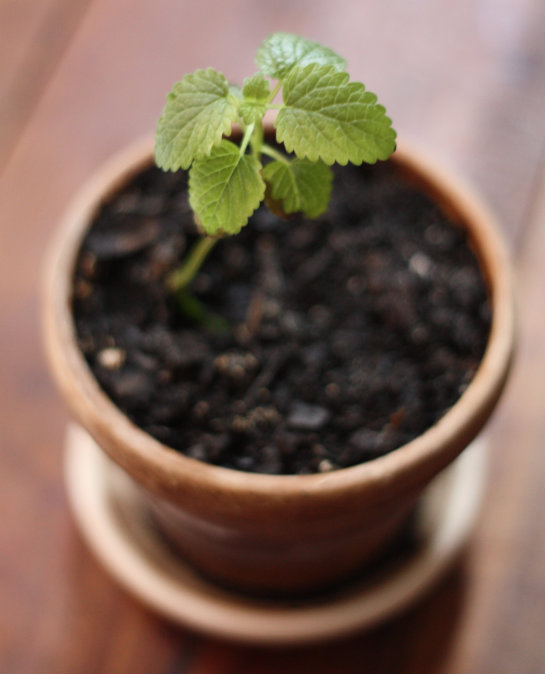Over the past year we've had luck in learning how to propagate and regrow different plants from cuttings. So far, we've mainly tackled the herb varieties like mint, rosemary and basil and today we wanted to show you how we went about it with lemon balm.
When we received the following bundle of fresh lemon balm in one of our weekly Farm Table Box deliveries, we were excited since we haven't grown any of our own before. I wasn't sure if it would even work since the stems had already been cut, but figured we had nothing to lose by giving it a whirl.
Lemon balm is a perennial herb in the mint family. The leaves have a gentle lemon scent, related to mint and are often used to add flavor in recipes or herbal teas. It's also known to attract honey bees and act as a mosquito repellant. As you can imagine, we thought it would be great to have a live plant around for the long haul instead of getting this one-time use out the bunch from the box.
We took this cutting right around the same time we were trying to propagate our basil plant, so kept them in the same water glass:
You can really see how much more quickly the basil plant took to rooting over about a 3-4 week timeframe:
After planting the basil cutting, we left the lemon balm in the same water glass to let it do its thing, and roots continued to grow slowly with each day that went by:
Over the next 3 weeks while the roots really took off, a powdery white mildew began to cover the bottom leaves of the original cutting (which we hear lemon balm can be prone to):
We'd been on various trips out of town during this timeframe so probably left the cutting in the water a little longer than necessary, contributing to the mildew. Check out the long root growth and little baby sprouts generating from the base of the stem here:
We decided it was time to plant it or get rid of it, so in the planter it went! You can see we're trying a couple sprigs of thyme now too!
Before planting, we just removed all of the leaves that had any sign of the white powdery mildew, leaving a couple smaller healthy leaves at the top of the cutting. We hoped this would help stimulate new healthy growth from here on out, allowing the plant's energy to focus on those fresher green leaves:
After a healthy watering in a soil-filled planter, we wished our little lemon balm cutting well as we took it back indoors to watch the progress:
Over the last 2 weeks, everything seems to have been going well. We've already got new growth on the top of the plant and can't wait to see how big this little guy gets over time!
The entire process from cutting through now probably took 2 1/2 months using this natural method with cuttings and water. It's a slow process, but fascinating to watch. As you can probably gather, we've had fun seeing how many different variations of plants we can regrow using this same natural propagation method. We love how many fresh herbs we've now got on hand to use here and there when needed in a recipe!
What have you been growing or propagating of late?
Discover More:














I have been working on some giant sage I spotted in the university lab and couldn't resist clipping! To show you how large the leaves are I could only find this recipe which I now want to try! Fingers crossed the cuttings make it
ReplyDeletehttp://www.flaviabi.com/en/2011/05/salvia-fritta-con-pastella-alla-birra-fried-sage/
That is some GIANT sage! Wow!
DeleteI love it! I've been waiting (not very patiently) to be able to grow a garden again since moving. I'm so excited to try all these out :)
ReplyDeleteWe are excited to hear,read, and see all about your garden!
DeleteI am going to try with my lemon balm to see if I am able to do it it looks like fun
DeleteI have a replanted Basil from an organic bunch and it is doing wonderfully, however, the organic seeds that I purchased and planted don't seem to be as vibrant in their growth. Many of the lower leaves are getting yellow--too much water?
ReplyDeleteHmmm....not sure where you are located but we have gotten a lot of rain here on the east coast and that has affected our plants. The great thing is you are growing your own herbs! Congrats!
DeleteThanks for the procedure, I think I can use the same methods to grow other plants too.
ReplyDeleteYou absolutely can!
DeleteOh joy !!! I sowed and grew lemon balm about 30 years ago ... It self seeds everywhere .. in every crack and space !! You will NEVER be without it ever again !!! While wonderful - be aware of how fast it self seeds. It dies down in winter but is soon up again in the spring !!!
ReplyDeleteMuch like catnip (cat mint) it too self seeds everywhere. :)
DeleteThis is a very late reply to the melissa rooting experiment. I intend to try it as I want some more quickly. I noticed it took quite a while for the melissa to get roots but it was in the same water as the basil. They are both very pungent plants and perhaps the chemical released by the basil root was overpowering the melissa. Did you try melissa in water on it's own. Thanks very much for your post. I am going to have a go at growing some cuttings in water tomorrow as well as using hormone rooting powder. Violet
ReplyDeleteHoney and maple syrup are natural hormones.
ReplyDelete